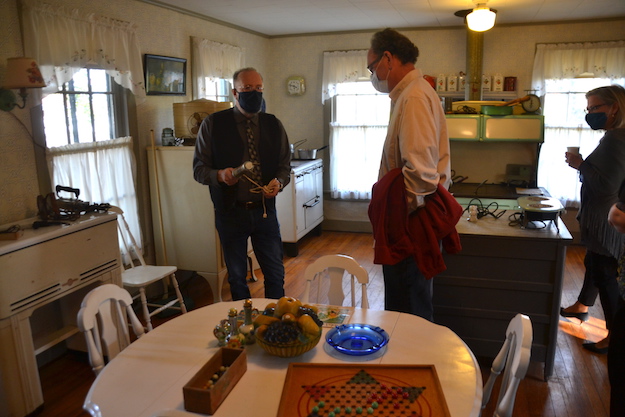Cobblestone Museum adds historic building, with Vagg House a showcase of life in 1920s
Site at corner of 98 & 104 has many household items from early days of electricity
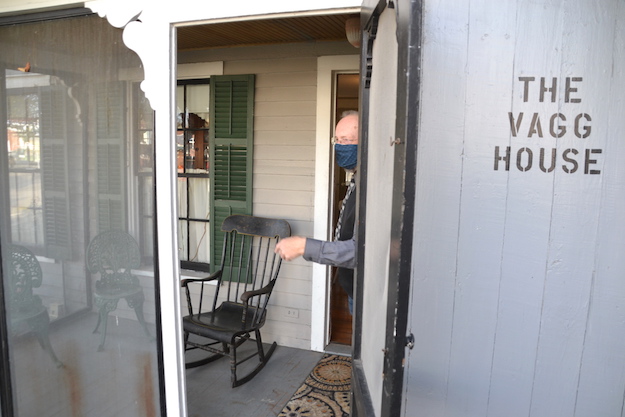
Photos by Tom Rivers: Bill Lattin, retired director of the Cobblestone Museum, welcomes people into the Vagg House for its first public tour on Nov. 7.
CHILDS – For the first time since 1998, the Cobblestone Society has acquired another historic building to add to its campus.
Located on the southwest corner of routes 104 and 98, the Vagg house was owned by blacksmith Joseph Vagg and his wife Nellie. Joseph’s adjoining blacksmith shop is already one of the eight buildings acquired over the years by the Cobblestone Society.
The home was last owned by Rene Schasel, who died in March 2019. Schasel, was a supporter of the Cobblestone Museum and an avid collector of antiques dating from 1910 through 1940. He was also a friend of Bill Lattin, former director of the Cobblestone Society, and named his sister Marena Rupert and Lattin as executors of his estate.
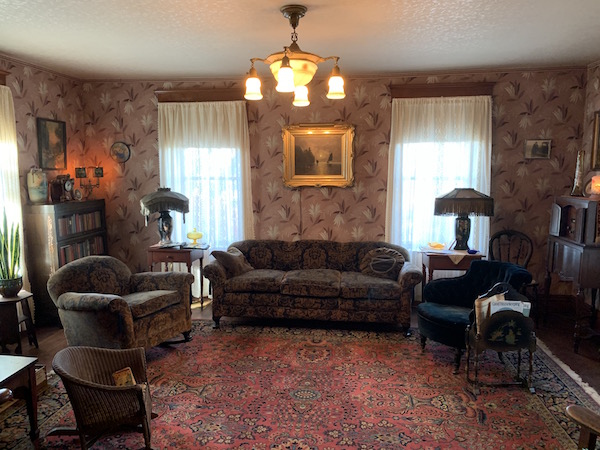
This overstuffed furniture with its original fabric dates to the mid-1920s.
It occurred to Cobblestone director Doug Farley and Lattin that the house would be going on the market and it would be a disaster if the home should fall into the hands of an “undesirable” owner, with the historic buildings of the Cobblestone Society being only a few feet away.
It became obvious to the executors this house should go to the museum.
With that in mind, the executors dropped the price of the home to $60,000, and an anonymous donation of $30,000 made it possible for the Cobblestone Society to arrange to buy the property. Farley said they will begin a fund drive in January to raise the remainder of the money.
The executors held three estate sales during the past year, but there was still a massive amount of items left. Schasel especially liked antique electrical appliances, and his collection included 200 flat irons, 100 waffle irons, 39 washing machines, 150 coffee pots, 40 vacuum cleaners and numerous refrigerators. There are various other appliances, such as a mangle (iron), electric flour sifter, 60 toasters, an electric coil to defrost the freezer and a pant creaser.

Members of the Cobblestone Museum get ready to go inside the Vagg House on Nov. 7, when it hosted its first public tour after hundreds of work from volunteers led by Bill Lattin. He thanked museum volunteers Camilla VanderLinden, Chris Sartwell, Pat Morrisey and Kim Charon for their cleaning skills to get the Vagg House ready for viewing.
After the first estate sale, Lattin said he realized they should keep enough of the things to maintain the integrity of the home and furnish it in the style of the 1920s.
“The home is now set up to interpret life as the Vaggs would have lived it in the 1920 and 1930s,” Farley wrote in the Cobblestone’s autumn newsletter.
Lattin also added that while the home is full of antique furnishings, they are not the kind of things a collector would be looking for.
“The Vaggs lived a very moderate lifestyle,” he said. “Many of their things were hand-me-downs.”
Lattin compiled the Vagg’s story for the autumn “Cobblestoner.”
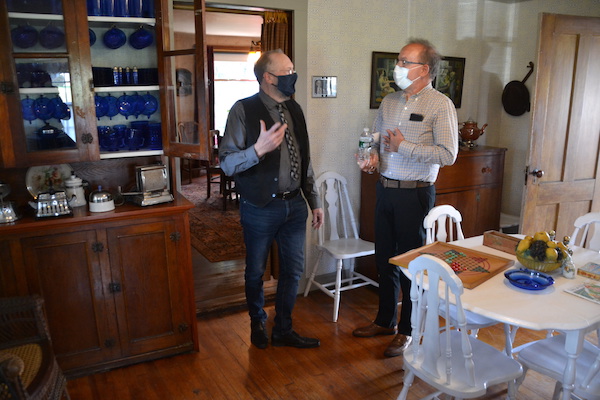
Bill Lattin gives museum trustee Mark Bower a tour of kitchen. This cupboard is full of cobalt blue Depression glass known as Modern Tone. This became very popular in the 1930s. With more than 30 cups and saucers it can be used for future teas.
Joseph and Nellie moved to Childs from Barre in 1909 with their two children Melva and Norris. Melva, who married Kenneth Warner, recalled she was 3 years old when they came to live at the corner of routes 98 and 104. After her mother died in the late 1970s, Melva inherited the home and lived there until she sold it in 1985 to William Nestle and Rene Schasel. Rene liked the house because he said it was “untouched.”
When Melva had the house for sale, Mark Tillman from the Village Inn looked at it and made the comment that the kitchen would have to be done over. Melva took great offense and stated “Young man, this kitchen was remodeled in 1929 and there is nothing wrong with it today.”
Schasel became sole owner of the house when Nestle, who was a former president of the Cobblestone Society, died in 2009.
Lattin felt the house could be used for small gatherings of less than 30 people, such as meetings, rehearsal parties or teas, put on by a caterer, as well as being part of the Cobblestone Museum.
Furnishings in the home include a Monitor Top refrigerator, a 1930’s kitchen table and chairs, an 1840 chest recently donated to the Museum by David and Camilla VanderLinden, a gray enamel sink, a Kalamazoo kitchen range made in 1935 and a Morris chair donated by Gerard and Pat Morrisey, which belonged to his grandfather, Poelma, and was built in 1917.
Other period furnishings are Royal Rochester waffle iron and coffee urn, a player piano and Orthophonic Victrola. Floor and table lamps with fringed shades, a wicker rocker, candle holders with shades and a hooked wall hanging which had been given to the museum. The wallpaper in the parlor was put up when the Vaggs celebrated their 45th wedding anniversary in 1948.
The property now boasts its own outhouse in the back yard, which Lattin built out of scrap lumber.
Lattin added that electricity was distributed down Ridge Road between 1926 and 1928. Prior to that, the Vaggs would certainly have had an outhouse.
Lattin quoted a sentence which was advertised in the 1920s, “Electricity is the only servant you will ever need.”
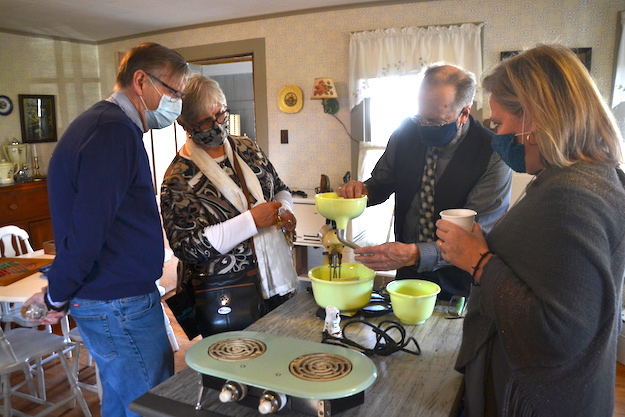
Bill Lattin shows Doreen and Gary Wilson a 1930s food mixer and a green enamel hot plate. There is also a Kalamazoo kitchen range was made in 1935. The Vaggs used it for heat as well as cooking. Museum Trustee Maarit Vaga is at right.
Keeping as much of the Vagg house in its original state is important because of Child’s designation by the Landmark Society of Western New York as one of their “Five to Revive” in 2019, Lattin said.
The house is also a perfect fit to the area, with Joseph Vagg’s blacksmith shop next door already part of the Cobblestone Museum. He built the shop in 1921 and Nellie bequeathed it to the Cobblestone Society after she died in 1975.
“This brings the Cobblestone Museum’s buildings to nine,” Farley said. “We have 18 if you count the outhouses. We are very excited to have a presence on this corner. The potential here is unlimited. This house will be included in our future tours.”
Farley said visitors will notice a big difference between the 1920s-era Vagg house and the cobblestone Ward house, furnished in the style of the 1880s.

In the dining room, a Royal Rochester waffle iron is plugged into the ceiling light fixture. In the corner is a Orthophonic Victrola dating to circa 1928. The 1920-era Vagg House represents a different era from the Ward House, which depicts life in the 1880s. Latin said in the 1920s it was advertised, “Electricity is the only servant you’ll ever need.”
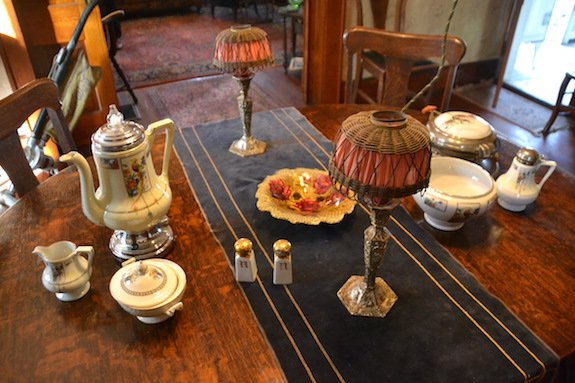
The shades on the candlesticks was very popular in the 1910s and ’20s.
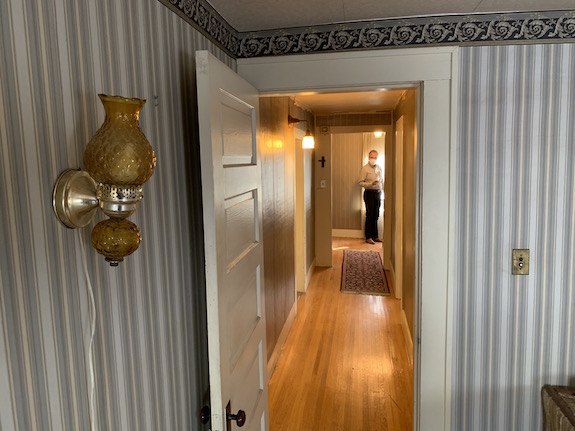
Mark Bower checks out the upstairs, where the hallways have hardwood floors.
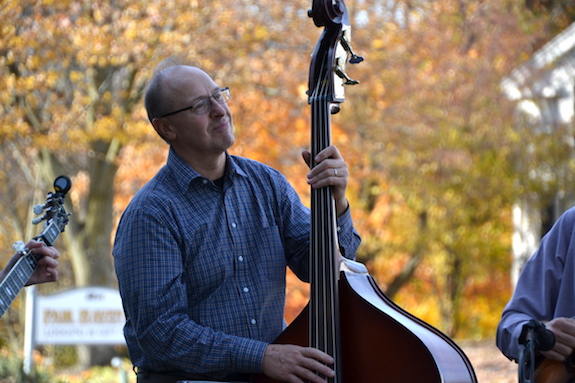
A member of Elderberry Jam performs on the lawn at the Vagg House for the event on Nov. 7.
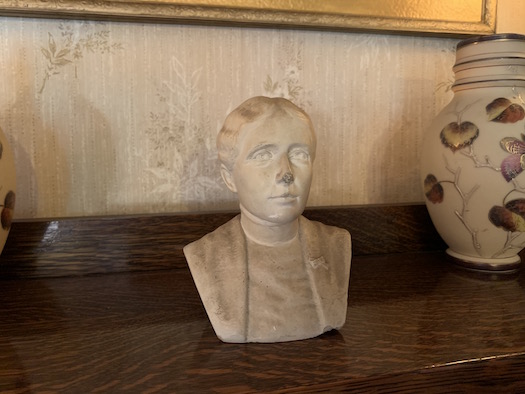
There is a small plaster bust of Frances E. Willard in the dining room. The bust, made in 1932, shows Willard wearing a small white ribbon, which was characteristic of the temperance movement. Willard was born in Churchville and became president of the National Women’s Temperance Union. Nellie Vagg also was active in the temperance movement and wore a white ribbon until her dying days. “Nellie was a warhorse on liquor,” Lattin said.


























